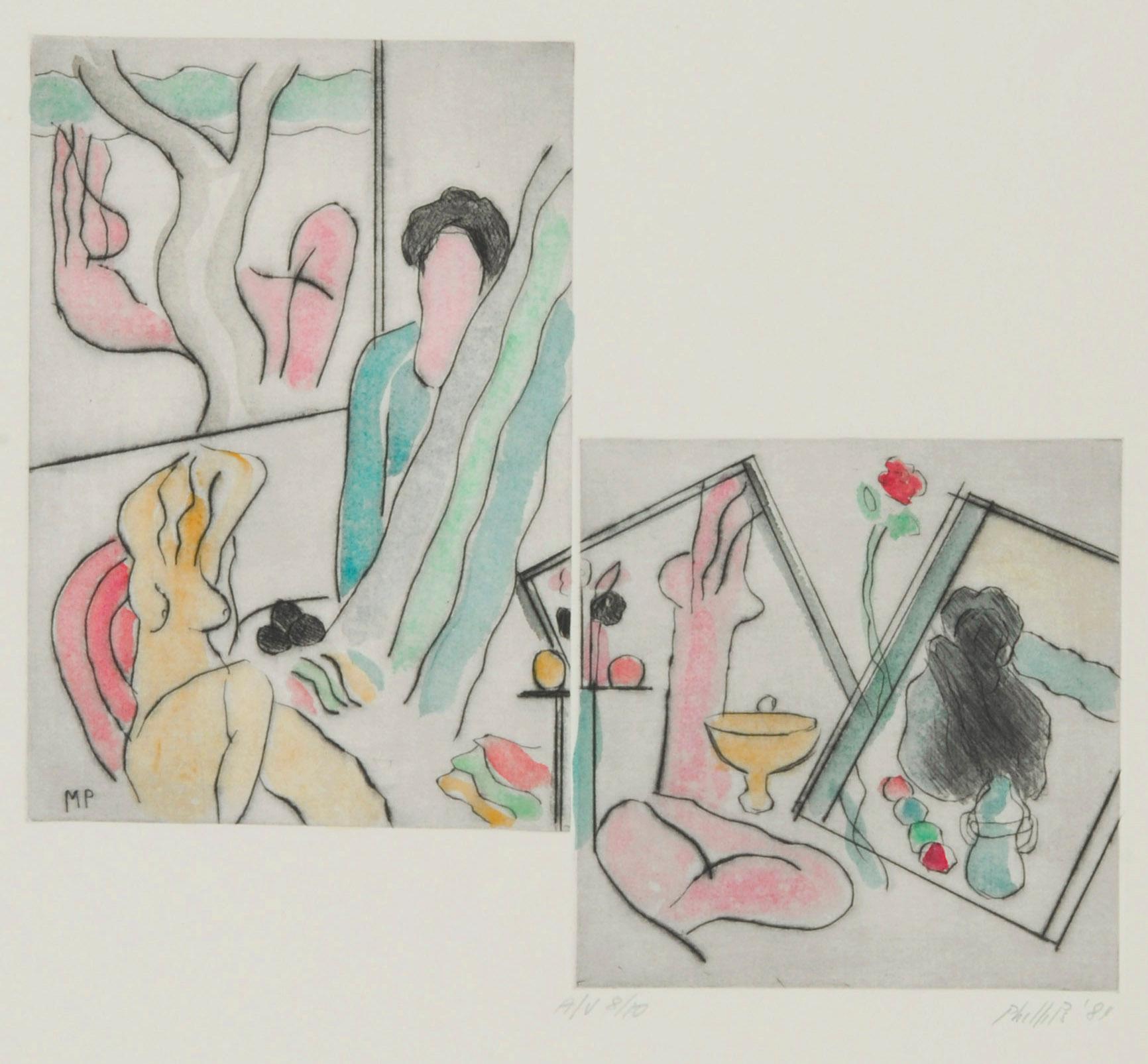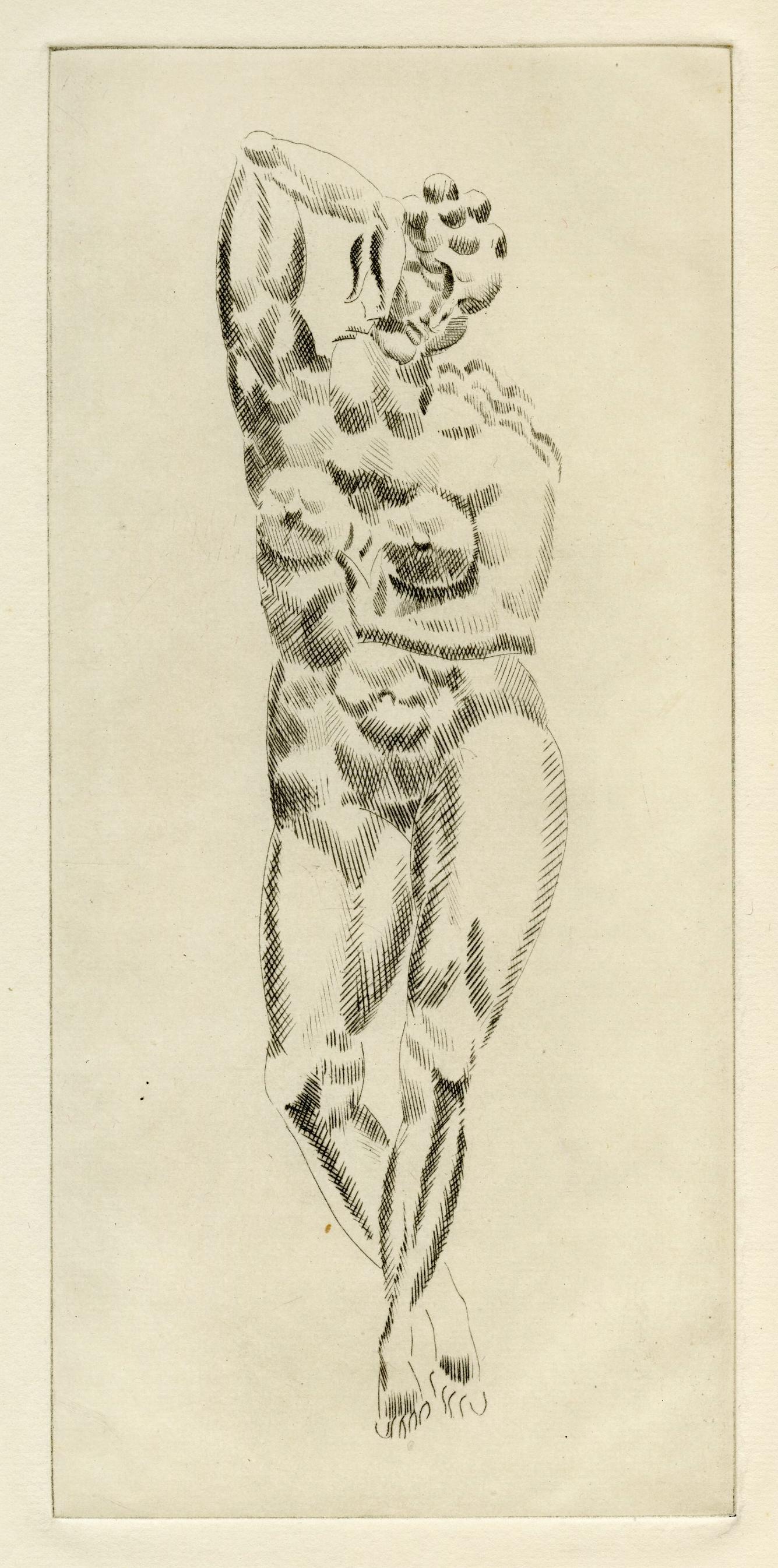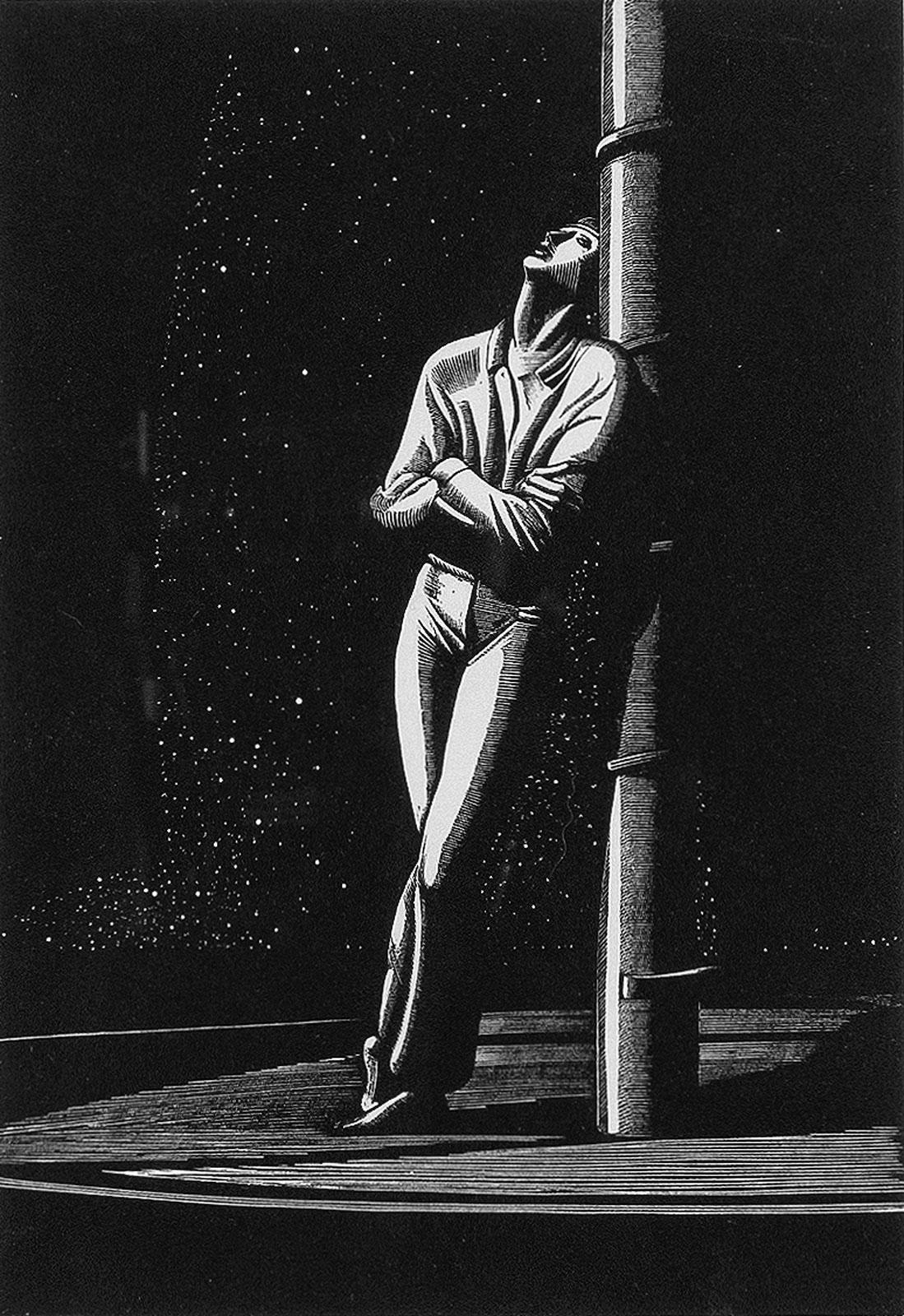Items Similar to 'Mokihana (Hawaii)' — 1940s Polynesian Portrait
Want more images or videos?
Request additional images or videos from the seller
1 of 3
John Melville Kelly'Mokihana (Hawaii)' — 1940s Polynesian Portrait1946
1946
About the Item
John Melville Kelly, 'Mokihana (Hawaii)', drypoint, 1946. Signed, titled, and annotated 'No 5' in pencil. A superb, finely nuanced impression, in dark brown ink, on cream wove Japan paper, with margins (3/4 to 1 5/8 inches); toning in the margins from a previous mat; paper fibre in the center left margin, away from the image; otherwise in excellent condition. Scarce.
Impressions of this work are in the permanent collections of The Honolulu Academy of Arts, the National Gallery of Art, and the University of Hawaii Library.
ABOUT THE ARTIST
“The best way of summing up the spring within the spring that made John Kelly labor relentlessly, and that raised him to etching eminence, is to quote from the catalog of the show the opening sentence written by John M. Kelly Jr., ‘Of all the things a man may love, his work, wife, family, country and fellow man, none can be truly his unless he loves life itself.”’
—Jean Charlot, review of John Kelly's retrospective exhibition held at the Honolulu Museum in 1962
John Melville Kelly (1879-1962) is one of the most beloved American printmakers and painters of the Hawaiian people, landscape, and culture during the early to mid-20th century. Born in Oakland, California, Kelly's artistic talents blossomed as he pursued formal training at the California School of Design (now known as the San Francisco Art Institute) and later at the Art Students League of New York City. His early works primarily focused on landscapes and seascapes, reflecting his love for the coastal scenery of California.
Like other artists in Hawaii during the first half of the twentieth century, Kelly traveled to Oahu with his wife, the sculptor Kate Kelly, in 1904, expecting to stay a year but remained a lifetime. He found inspiration in the lush tropical landscapes, vibrant flora, and the rich cultural tapestry of the Hawaiian islands. Over the following decades, Kelly gained renown for his sensitive depictions of native Hawaiians as well as his dramatic renderings of the islands’ majestic volcanoes, cascading waterfalls, serene beaches, and bustling marketplaces. Captivated by the unique light and colors of Hawaii, Kelly's artistic style evolved, marked by bold brushwork, vivid colors, and a deep sense of emotional connection to his subjects.
Kelly played a pivotal role in fostering artistic expression in Hawaii, serving as a mentor to emerging artists and contributing to the establishment of the art institutions of Hawaii. His passion for preserving the cultural heritage of the islands led him to document traditional Hawaiian rituals, customs, and everyday life, ensuring that future generations would have a visual record of the islands' rich history. Kelly was one of the founding members of the Honolulu Printmakers in 1928. The organization honored him in 1934 and 1953 by selecting him to create the member gift print that accompanies their annual exhibition.
Throughout his prolific career, Kelly received numerous awards and accolades for his artistic achievements, including recognition from prestigious institutions such as the National Academy of Design and the California Society of Printmakers. His works were exhibited in prominent galleries and museums across the United States, garnering admiration from audiences worldwide. In 2005, the Honolulu Academy of Arts presented Hawaiian Idyll: The Prints of John Kelly, an extensive exhibition of the artist's work drawn from the Academy's preeminent collection of prints.
The De Young Museum, Fogg Museum (Harvard), Hawaii State Art Museum, Honolulu Academy of Arts, National Gallery of Art, Nelson-Atkins Museum of Art, Saint Joseph College Art Gallery (West Hartford, Connecticut), San Diego Museum of Art, and the Smithsonian American Art Museum are among the public collections holding work by John Melville Kelly.
- Creator:John Melville Kelly (1878 - 1962, American)
- Creation Year:1946
- Dimensions:Height: 11.5 in (29.21 cm)Width: 9 in (22.86 cm)
- Medium:
- Movement & Style:
- Period:
- Condition:
- Gallery Location:Myrtle Beach, SC
- Reference Number:
About the Seller
5.0
Recognized Seller
These prestigious sellers are industry leaders and represent the highest echelon for item quality and design.
Platinum Seller
These expertly vetted sellers are 1stDibs' most experienced sellers and are rated highest by our customers.
Established in 1995
1stDibs seller since 2016
254 sales on 1stDibs
Typical response time: 1 hour
Associations
International Fine Print Dealers Association
- ShippingRetrieving quote...Ships From: Myrtle Beach, SC
- Return PolicyA return for this item may be initiated within 7 days of delivery.
More From This SellerView All
- Kanani (Hawaii)— 1940s Polynesian PortraitBy John Melville Kelly 1Located in Myrtle Beach, SCJohn Melville Kelly, 'Kanani (Hawaii)', drypoint, 1946. Signed, titled and annotated 'No 36' in pencil. A superb impression, in dark brown ink, on ...Category
1940s American Modern Nude Prints
MaterialsDrypoint
- 'Eyes for the Night' — Mid-century ModernismBy Benton Murdoch SpruanceLocated in Myrtle Beach, SCBenton Spruance, 'Eyes for the Night', lithograph, 1947, edition 35, Fine and Looney 260. Signed, dated, titled, and annotated 'Ed 35' in pencil. A fine impression, on heavy, cream ...Category
1940s American Modern Figurative Prints
MaterialsLithograph
- 'Madman's Drum (Plate 41)' — 1930s Graphic ModernismBy Lynd WardLocated in Myrtle Beach, SCLynd Ward, 'Madman's Drum, Plate 41', wood engraving, 1930, edition small. Signed in pencil. A fine, black impression, on off-white tissue-thin Japan paper; the full sheet with margins (1 5/8 to 2 1/2 inches); a small paper blemish in the upper right margin, away from the image, otherwise in excellent condition. Scarce. Matted to museum standards, unframed. Image size 5 1/2 x 3 3/4 inches (140 x 95 mm); sheet size 9 5/8 x 7 1/8 inches (244 x 181 mm). From Lynd Ward’s book of illustrations without words, 'Madman’s Drum', Jonathan Cape and Harrison Smith, New York, 1930. Illustrated in 'Storyteller Without Words: The Wood Engravings of Lynd Ward', Harry Abrams, New York, 1974. Reproduced in 'Storyteller Without Words, the Wood Engravings of Lynd Ward', Harry N. Abrams, New York, 1974. ABOUT THE ARTIST Lynd Ward is acknowledged as one of America’s foremost wood engravers and book illustrators of the first half of the twentieth century. His innovative use of narrative printmaking as a stand-alone storytelling vehicle was uniquely successful in reaching a broad audience. The powerful psychological intensity of his work, celebrated for its dynamic design, technical precision, and compelling dramatic content, finds resonance in the literature of Poe, Melville, and Hawthorne. Like these classic American writers, Ward was concerned with the themes of man’s inner struggles and the role of the subconscious in determining his destiny. An artist of social conscience during the Great Depression and World War II, he infused his graphic images with his unique brand of social realism, deftly portraying the problems that challenged the ideals of American society. The son of a Methodist preacher, Lynd Ward, moved from Chicago to Massachusetts at an early age. He graduated from the Teachers College of Columbia University, New York, in 1926, where he studied illustration and graphic arts. He married May Yonge McNeer in 1936 and left for Europe for their honeymoon in Eastern Europe. After four months, they settled in Leipzig, where Ward studied at the National Academy of Graphic Arts and Bookmaking. Inspired by Belgian expressionist artist Frans Masereel's graphic novel ‘The Sun,’ and another graphic novel by the German artist Otto Nückel, ‘Destiny,’ he determined to create his own "wordless" novel. Upon his return to America, Ward completed his first book, ‘God's Man: A Novel in Woodcuts,’ published in 1929. ‘Gods’ Man’ was a great success for its author and publisher and was reprinted four times in 1930, including a British edition. This book and several which followed it, ‘Madman’s Drum,’ 1930, ‘Wild Pilgrimage...Category
1930s American Modern Figurative Prints
MaterialsWoodcut
- 'Sea And Sky' — 1930s ModernismBy Rockwell KentLocated in Myrtle Beach, SCA brilliant, black impression, on cream wove Japan; the full sheet with margins (2 to 2 1/2 inches), in excellent condition. Edition 150. Signed in pencil. Matted to museum standards...Category
1930s American Modern Nude Prints
MaterialsWoodcut
- 'Girl with Hands to Face' — Mid-century ModernismBy Benton Murdoch SpruanceLocated in Myrtle Beach, SCBenton Spruance, 'Girl with Hands to Face', two-color lithograph, 1940, edition 30, Fine and Looney 180. Signed, titled, and annotated 'Ed. 30' in pencil. A superb impression, on cr...Category
1940s American Modern Figurative Prints
MaterialsLithograph
- 'Mountain Climber' — 1930s American ModernismBy Rockwell KentLocated in Myrtle Beach, SCRockwell Kent, 'Mountain Climber', wood engraving, 1933, edition 250, Burne Jones 93. Signed in pencil. A brilliant, black impression, on cream, wove Japan paper; the full sheet with margins (2 9/16 to 3 5/8 inches); slight skinning at the top sheet edge verso, where previously hinged; otherwise, in excellent condition. Archivally matted to museum standards, unframed. Image size 7 7/8 x 5 7/8 inches (200 x 149 mm); sheet size 14 x 11 1/8 inches (356 x 283 mm). Printed by Pynson Printers, New York. Distributed by The Print Club of Cleveland, Publication No. 11, 1933. Literature: 'Rockwellkentiana,' Harcourt, Brace and Company, New York, 1933. '101 of The World’s Greatest Books', edited by Spencer Armstrong, 1950. Impressions of this work are held in the following museum collections: Akron Art Institute, Burne Jones Collection, IL; Cincinnati Art Museum; Cleveland Museum of Art; Columbus Gallery of Fine Arts; Crystal Bridges Museum of American Art; Davis Museum at Wellesley College; Fine Art Museums of San Francisco; H. M. de Young Museum; Hermitage Museum; Kent Collection, NY; Library of Congress; Memorial Art Gallery, University of Rochester; Metropolitan Museum of Art; New York Public Library; Philadelphia Museum of Art; Princeton University Library; Smithsonian American Art Museum, Spector Collection, NY; SUNY, Plattsburg. ABOUT THE ARTIST Rockwell Kent (1882-1971), though best known as a painter, graphic artist, and illustrator, pursued many careers throughout his life, including architect, carpenter, explorer, writer, dairy farmer, and political activist. Born in Tarrytown, New York, Kent was interested in art from a young age. These ambitions were encouraged by his aunt Jo Holgate, an accomplished ceramicist. Jo came to live with the family after Kent’s father passed away in 1887 and took him to Europe as a teenager, undoubtedly kindling his interest in exploring the world. Kent attended the Horace Mann School in New York City, where he excelled at mechanical drawing. His family’s financial circumstances prevented him from pursuing a career in the fine arts; however, after graduating from Horace Mann in 1900, Kent decided to study architecture at Columbia University. Before matriculating at Columbia, Kent spent the first of three consecutive summers studying painting at William Merritt Chase’s art school in Shinnecock Hills, Long Island. There he found a community of mentors and fellow students who encouraged him to pursue his interest in art. At the end of Kent’s third summer at Shinnecock, Chase offered him a full scholarship to the New York School of Art, where he was a teacher. Kent began taking night classes at the art school in addition to his architecture studies but soon left Columbia to study painting full-time. In addition to Chase, Kent took classes with Robert Henri and Kenneth Hayes Miller, where his classmates included the artists George Bellows and Edward Hopper. Kent spent the summer of 1903 assisting the eccentric painter Abbott Handerson Thayer at his studio in Dublin, New Hampshire—a position he secured through the recommendation of his Aunt Jo. Thayer’s naturalist lifestyle and almost mystical appreciation for natural phenomena greatly influenced Kent; he returned to Dublin for many years to visit Thayer and his family. Thayer gave the young artist time to pursue his work, and that summer Kent painted several views of the New Hampshire landscape, including Mount Monadnock. In 1905 Kent moved from New York to Monhegan Island in Maine, home to a summer art colony, where he continued to find inspiration in nature. Kent soon found success exhibiting and selling his paintings in New York, and in 1907, he was given his first solo show at Claussen Galleries. The following year he married his first wife, Kathleen Whiting (Thayer’s niece), with whom he had five children. The couple divorced in 1924, and Kent married Frances Lee the following year. They divorced after 15 years of marriage, and the artist married Sally Johnstone. For the next several decades, Kent lived a peripatetic lifestyle, settling in several locations in Connecticut, Maine, and New York. During this time he took several extended voyages to remote, often ice-filled, corners of the globe, including Newfoundland, Alaska, Tierra del Fuego, and Greenland, to which he made three separate trips. For Kent, exploration and artistic production were twinned endeavors, and his travels to these rugged, elemental locations inspired his visual art and his writings. He developed a stark, realist landscape style in his paintings and drawings that revealed both nature’s harshness and its sublimity. Kent’s human figures, which appear sparingly in his work, often allude to the mythic themes of isolation, individualism, heroism, and the quest for self-connection. Important exhibitions of works from these travels include the Knoedler Gallery’s shows in 1919 and 1920, featuring Kent’s Alaska drawings...Category
1930s American Modern Nude Prints
MaterialsWoodcut
You May Also Like
- Plate 2By Matt PhillipsLocated in Fairlawn, OHPlate 2 2 plate drypoint with hand coloring, 1984 Signed and numbered in pencil (see photos) From: Barcelona Suite (6 plates) Edition: A/P 8/10 in pencil lower left Signed in pencil with the artist's initials and dated, lower right Condition: Excellent Image/combined plate size: 12 1/4 x 14 inches From a very are set. I an find not reference to the suite or the individual plates, including Stanford Library and the de Young and Legion of Honors museums in San Francisco. "Matt Phillips lived in Atlantic City, New Jersey, for a time and then moved to Philadelphia. In 1952 he earned an M.A. degree at the University of Chicago and then studied at Stanford University. After traveling extensively in Europe, Phillips accepted a teaching position at Pennsylvania State University. He returned to Europe in 1962 to teach for two years at the American College in Paris. On his return to the United States in 1964, Phillips joined the faculty of Bard College in upstate New York, where he taught until moving to California in 1987. As early as 1961, Phillips had begun making monotypes and writing about the process. His efforts to organize monotype exhibitions, as well as his own concentration on the medium, helped to reintroduce contemporary artists to a technique that had been favored by ninteenth-century artists. Phillips?s subtle and delicate prints have been inspired in part by the monotypes of Maurice Brazil Prendergast...Category
1980s American Modern Nude Prints
MaterialsDrypoint
- Four Nudes in a LandscapeBy Jan MatulkaLocated in New York, NYJan Matulka (1890-1972), Four Nudes in a Landscape, drypoint, c. 1923, signed in pencil lower right margin [also with initials in the plate lower left]. Ref...Category
1920s American Modern Nude Prints
MaterialsDrypoint
- Female Nude - Standing Female Nude (Havard)By Elie NadelmanLocated in Fairlawn, OHFemale Nude - Standing Female Nude (Havard) Drypoint, 1920 Unsigned, as issued in the portfolio No signed impression are known to exist From: The Drypoint...Category
1920s American Modern Nude Prints
MaterialsDrypoint
- ArisingBy Alessandro Mastro-ValerioLocated in Fairlawn, OHArising Mezzotint, 1942 Signed in pencil lower right (see photo) Publisher : Issued by the Miniature Print Collectors Society. Edition: 200 Condition: Mint Archival framing with Museum Glass Image/Plate size: 2 3/8 x 2 7/8 inches Sheet size: 3 3/4 x 4 5/8 inches Archival Framed: 17 1/4 x 15 1/4 inches Mastro-Valerio was educated at the Salvador Rosa Institute in Naples, Italy (1906-1912), and came to the U.S. in 1913. He settled in Chicago, and after a brief period as a commerical artist, established a portrait studio near the Loop. Among his patrons were the industrialists Harvey S...Category
1940s American Modern Nude Prints
MaterialsMezzotint
- Man at MastBy Rockwell KentLocated in New Orleans, LAA lookout starkly rendered in the art deco style straddles the mast of a ship as he surveys the landscape. Rockwell Kent's wood engraving issued in 1930 in an edition of 120. it is ...Category
Early 20th Century American Modern Figurative Prints
MaterialsWood, Engraving
- Torse, bras gauche derrière la têteBy Henri MatisseLocated in New York, NYHenri Matisse Torse, bras gauche derrière la tête, 1926 drypoint, on chine appliqué, signed in pencil and numbered 4 from the edition of 7 Plate: 5 13/16 x 3 7...Category
1920s Modern Nude Prints
MaterialsDrypoint




